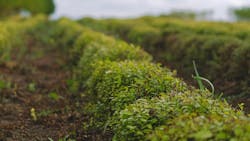NORWAY -- Nutrients contained in wastewater, such as phosphorous and nitrogen, can be put to good use as fertilizers. Municipal wastewater treatment plants are now planning to recover more of these valuable resources, which are becoming globally scarce.
"Wider Uptake" is a joint project involving water and sewage treatment companies, research institutes and private sector businesses in five countries. The aim of the project is to find out how to optimize water resource exploitation, limit discharges, and develop sustainable business models within the water management sector.
"And it doesn't necessarily depend on the technology, because there is no shortage of systems for recycling resources from wastewater," says Project Manager Herman Helness at the Norwegian research organization SINTEF. "Bottlenecks are usually due to the regulations and a lack of business models," he says.
Recovering more phosphorous
The water, sewage and refuse management company IVAR IKS, based in the Norwegian county of Rogaland, is participating in one of Wider Uptake's demo projects. In collaboration with a company called Høst verdien i avfall AS, it is recovering phosphorous contained in wastewater slurries to produce fertilizer and soil products, as well as biogas and energy.
"In the past, sewage treatment focused mainly on removing organic material, and valuable resources were lost during the process," says Leif Ydstebø, who is a Technical Manager responsible for slurries and biogas at IVAR. "We're now working to recover the nutrients instead of discharging them into the sea," he says.
When sludge is removed from the wastewater, it contains both nitrogen and phosphorous, but not in sufficient quantities to be used as an effective fertilizer. In order to recycle even more of the phosphorous, the plan is to recover a substance called struvite, which contains both elements.
"Our plan is to install new recycling technology in the wastewater plant. To do this we first have to run a variety of laboratory tests to identify the method that is best suited to our facility," says Ydstebø.
The aim is to make plant operations as profitable as possible for the twelve Rogaland municipalities that own it.
Influencing legislation and farmers
Sludge-based fertilizers can be used for cereal production, but not for grass silage.
"Market surveys among cereal farmers have revealed that many are basically sceptical of using sludge-based fertilizers. However, they soon became interested when they heard that the price was lower than for other types of fertilizer," says Erik Norgaard, who is a microbiologist heading research and development work at HØST.
Norgaard says that requirements set out in Norwegian statutory regulations governing fertilizer use also make it difficult to sell such products at a profit. Requirements include an obligation to notify municipal physicians of the use of sludge-based fertilizers. This was one of the factors that fueled skepticism among the farmers.
"Following prolonged discussions with the authorities, we succeeded in obtaining a dispensation from this requirement," says Norgaard.
A stable regulatory framework is essential for the development of new products and trading agreements. The technology is developing more rapidly than the legislation, but there is always a major investment risk when the regulations are unpredictable.
Norgaard also wants to persuade farmers to be more interested in soil health.
"Organic fertilizers are not what they were some decades ago," he says. "The wastewater grid has been renovated. Fewer copper pipes mean less heavy metals in the wastewater and slurries from which we manufacture the fertilizer. Norwegian farmers can now move into organic farming with confidence," says Norgaard.
Phosphorous is becoming scarce around the world IVAR and HØST envisage major export opportunities, and during the last six years the companies have supplied large volumes of fertilizer to Vietnam.
It is a fact that modern agriculture is entirely dependent on phosphorous fertilizers in order to produce sufficient food. In Norway we have adequate phosphorous in our soils, but this is not the case in the rest of the world. It is therefore good resource management to recover phosphorous and export the fertilizer.



